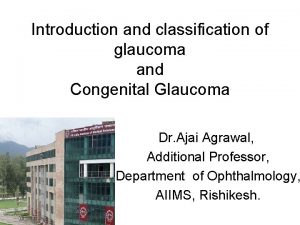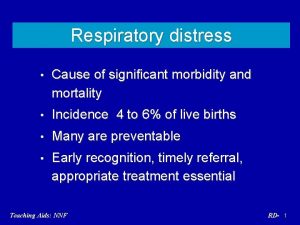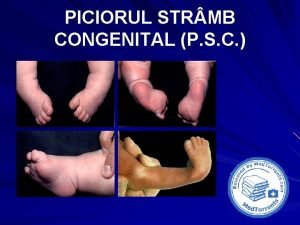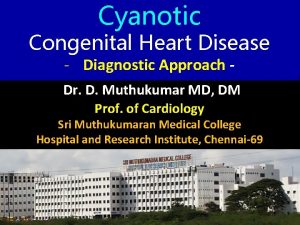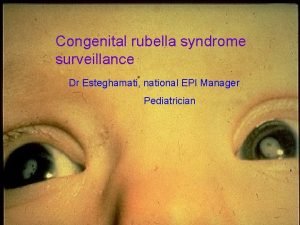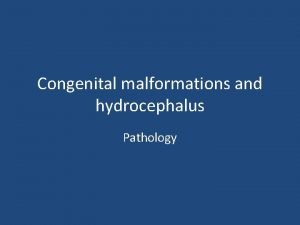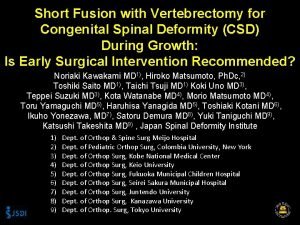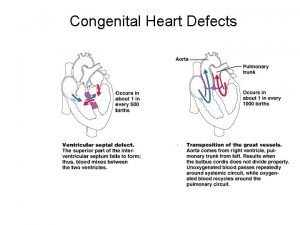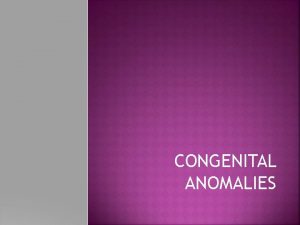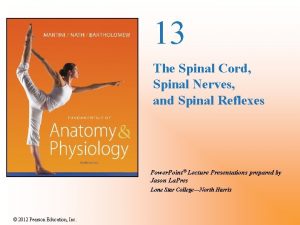Novel Classification in Congenital Spinal Deformity Noriaki Kawakami












- Slides: 12

Novel Classification in Congenital Spinal Deformity Noriaki Kawakami, Toshiki Saito, Taichi Tsuji Kazuki Kawakami, Tetsuya Ohara, Yoshitaka Suzuki, Ayato Nohara, Ryoji Tauchi, Department of Orthopedics & Spine Surgery, Meijo Hospital, Nagoya, Japan

Introduction Congenital spinal deformity (CSD) including scoliosis and kyphosis is defined as spinal deformity caused by solitary or multiple congenital vertebral anomalies. We should NOT include any spinal deformity that exist at birth without any congenital vertebral anomalies. At present, mainly two classifications of CSD exist, one is based on the plain X-ray findings, which has been established by Winter 1, 2), Mc. Master 3) and another that is based on 3 DCT findings reported by Kawakami, et al 5). The former classified CSD into three categories: Formation failure (FF), Segmentation failure (SF), and Mixed type (MT). While this classification has been widely used for analysis of congenital scoliosis and kyphosis, there are some known cases of CSDs with atypical vertebral anomalies, which do not belong to any of the aforementioned three categories. This is because it is based on radiographic findings recognized on plain X-ray images.

Confusion and Issues in Winter’s Classification (1) 1) How should you classify these two CSD? This first case may be diagnosed as Contralateral Hemivertebrae (Hemimetamelic shift) and classified into formation failure. Those are a fully segmented hemivertebra on the L 2 left side and a semisegmented hemivertebra on the L 4 right side. However, there almost normal lamina from T 12 -L 5. Can this pair of hemivertebrae be classified into formation failure? 4 7 8 4 5 5 6 6 7 8 9 7 10 10 11 12 8 9 11 12 This second case is very difficult to classify using Winter’s classification. There were no typical vertebral anomalies on the anterior structure except slight wedging on the T 8 vertebral body, however, with multiple hemilaminae and one of them being semisegmented in the posterior structure. Winter’s classification dose not consider posterior structure anomalies.

Confusion and Issues in Winter’s Classification (2) 2) Which vertebra is “congenitally abnormal”? Segmentation failure Formation failure Fully- segmented Semisegmented Nonsegmented Unilateral nonsegmented bar Block vertebrae It is easy to identify an abnormal vertebra if a fully-segmented vertebral anomaly exists. However, if a vertebral anomaly is combined with segmentation anomaly, it is difficult to identify whether it is normal or abnormal. Outstanding issues of Winter’s classification are 1) Evaluation of only vertebral body using plain X-ray images. 2) All formation failures as well as those that occur in conjunction with segmentation failure are included in formation failure. 3) The mixed type category includes almost all unclassified vertebral anomalies and in its current form, is a “waste bin. ”

Kawakami’s Classification 5) On the other hand, the latter introduces discordancy, which may be a clue to solve the puzzle of CSD. One of problems in this 3 D classification is its complexity and its inherent difficulty to understand. ◆Type 1 Solitary Simple (Unison) Hemivertebra Wedge vertebra Butterfly vertebra Defect Others Discordancy in CSD ◆Type 2 Multiple Simple (Unison) Combination of Hemiv. Wedge v. Butterfly v. Discrete, adjacent, or others ◆Type 3 Complex (Discordant) Mismatched complex type Mixed complex type ◆Type 4 No abnormal formation pure segmentation failure Nakajima, Kawakami, et al. 20074) Kawakami, et al. 20095)

Purpose of This Study The purpose of this study was to analyze 3 D anatomical relationship of CSD in terms of discordancy and to introduce a novel classification of CSD by dividing them into four categories. Materials From 2001 to 2013, 566 patients with CVA visited Meijo Hospital complaining back deformity. Spinal deformity in 566 patients varied from none or slight to very severe. Of them, 332 patients with CSDs were evaluated using 3 D-CT images to investigate whether a) they should be surgically treated or b) to determine surgical strategy for vertebrectomy. These 332 patients were materials of this study. Open spine lesions including spina bifida except those existed in only the sacrum were excluded in this study. Methods According to 3 D-Classification presented by Kawakami, et al, 331 were classified into four types such as SS, MC, and SF. Anterior, posterior structure, and the relationship between them in each patient were evaluated according to the algorithm of evaluating CSD by two well-experienced spine surgeons (NK, TS) who were familiar with 3 D-CT images of CSD. 3 D-CT images were mainly taken using the TOSHIBA Aquilion 64, and the slice thickness was 2 mm. Three-dimensional images were expressed by volume rendering.

Types of Vertebral Anomalies in 332 patients. Mean age of 332 patients at the time of CT: 8. 9 years (2 -50) Sex of the patients: male in 144, female in 187. SF 35 MC 124 Discordant Anomaly SS 104 MS 68 Number of patients All patients Patients with MC Patients with mismatch (+) in MC 332 124 38 Evaluation of discordancy in 38 patients with the MMC type clarified that 12 of 38 patients exhibited very unusual vertebral anomalies in addition to mismatch phenomena. They could be subclassified into three types, anterior, posterior, and anteroposterior.

Twelve Patients with Vertebral Anomalies with Sole Mismatch Phenomena Case Sex Type Vertebral anomalies scoliosis 1 M Anteroposterior Rt. T 3(FSHV+discordant SSHL), Rt. T 7 & Rt. T 11(SSHV+SSHL), Lt. L 5(FSHV+SSHL) 60 2 F Anteroposterior Lt. T 8, Rt. L 1 (FSHV+discordant FSHL) 55 3 M Anteroposterior Lt. T 10(FSHV+FSHL)、Rt. T 12(SSHV、discordant FSHL) 19 4 F Anteroposterior Rt. T 3 (FSHV+discordant FSHL), Lt. T 6(FSHV+SSHV), Rt. T 8(FSHV+SSHL), Lt. T 10( SSHV+discordant SSHL) 32 5 F Anteroposterior Lt. T 7 (FSHV+discordant FSHL), Rt. T 10 (SSHV+discordant SSHL), Lt. L 1 (SSHV+discordant SSHL) 35 6 M Anteroposterior Lt C 7(SSHV+NL)、Rt T 7(SSHV+NL), T 8 -T 10 Hemilamina 51 7 M Anteroposterior Lt. T 10 (FSHV+discordant FSHL), T 12(BV), Rt. L 2(FSHV+SSHL), Lt. L 6 (pedicle defect) 45 8 F Anteroposterior Rt T 1(SSHV+FSHL), Lt. T 8 (FSHV+NL), Rt. T 10 (SSHV+NL)、Rt. T 13 (SSHV+NL) 32 9 F Anterior Lt. T 1 (FSHV+NL)、Rt. T 8 (FSHV+NL)、Lt. T 13 (FSHV+NL) 65 10 F Anterior Lt. L 2 (FSHV+NL), Rt. L 4 (SSHV+NL) 36 11 F Posterior Lt. T 5 (NVB+FSHL), Rt. T 6 (NVB+FSHL) 33 12 M Posterior Rt. T 6(NVB+FSHL), Lt. T 8 (NVB+SSHL), Lt. T 9 (NVB+SSHL), Rt. T 10 (NVB+FSHL) 40 FSHV: fully-segmented hemivertebral body, SSHV: semisegmented hemivertebral body, BV: butterfly vertebra FSHL: fully-segmented hemilamina, SSHL: semisegmented hemilamina, NVB: normal vertebral body, NL: normal lamina

Three Types of Unusual Vertebral Anomalies with Mismatch Phenomena The Anterior type The Posterior type The Anteroposterior type Left: almost normal laminae (L 1 -L 5) with contralateral hemilvertebrae. Middle: multiple contralateral hemilainae with almost normal vertebral bodies Right: discordant combination with multiple contralateral hemivertebral bodies and multiple contralateral hemilaminae. Common features of these 3 types: 1) Discordant anomaly with a discordant combination of normal vertebral bodies and/or laminae 2) It was hard to identify the normal vertebrae from the abnormal.

Discussion 1) While these three types may look like some other type of formation failure due to the existence of discordancy, they should not be grouped in neither formation failure or segmentation failure. 2) Tsou 6) reported the development mechanism of hemivertebrae; even a single hemivertebra is formed by hemimetameric asynchronous development, which is thought as false fusion of primordia during this period. 3) Lehman reported that contralateral hemivertebrae were formed by false coupling of somites 7). Based on these developmental considerations of the mismatch phenomena; it should be separated from formation failure, which can be explained by the concept of partial formation failure of the vertebrae. We have grouped these three types that are caused by the mismatch phenomena together and named it as “Coupling failure”, the new fourth category of CSD. 4) The Mixed type in classification presented by Winter and Mc. Master and the Mixed complex type in classification by Kawakami, et al. could be regarded as an assembly of multiple vertebral anomalies due to combination of formation, segmentation, and/or coupling failure. In other words, this type can be expressed as a “Mixed failure. “

A Proposal of a New Classification of Congenital Spinal Deformity n We propose a new classification of congenital spinal deformity adding the fourth category “coupling failure” New Classification Formation failure Segmentat ion failure Mixed type Winter (1983) Mc. Master (1994) Formation failure Coupling failure Segmentation failure Mixed failure • Solitary simple • Multiple simple • Segmentation failure ( no formation failure) Mixed complex • Mismatch malformation • Complex malformation Kawakami, et al (2009)

Literature 1. 2. 3. 4. 5. 6. 7. Winter RB. Congenital Scoliosis. Clin Orthop & Relat Res. 93: 75 -94, 1973. Winter RB. Congenital Deformities of the Spine. New York, NY: Thieme- Stratton; 1983. Mc. Master M J : Congenital Scoliosis. In The Pediatric Spine (Weinstein SL. edit. ) Raven Press, New York, 227~244, 1994 Nakajima A, Kawakami N, Imagama S, et al. Three-Dimensional Analysis of Formation Failure in Congenital Scoliosis Spine 32: 562– 567, 2007. Kawakami N, Tsuji T, Imagama S, et al. Classification of Congenital Scoliosis and Kyphosis. A New Approach to the Three-Dimensional Classification for Progressive Vertebral Anomalies Requiring Operative Treatment. Spine 34: 1756– 1765. 2009. Tsou PM, Arthur Y, Hodgson AR. : Embryogenesis and parenatal development of congenital vertebral anomalies and their classification. Clin Orthop & Relat Res 152: 211 -231, 1980 Hermann Lehmann-Facius: Die Keilwirbelbildung bei der kongenitalen Skoliose. Frankfurt Z. Path. 31: 489. 1925
 Otojiro kawakami
Otojiro kawakami Art-labeling activity figure 13.6a (1 of 2)
Art-labeling activity figure 13.6a (1 of 2) Figure 13-1 the spinal cord
Figure 13-1 the spinal cord Spinal cord anatomy
Spinal cord anatomy Inferior gluteal nerve
Inferior gluteal nerve Trabeculodysgenesis meaning
Trabeculodysgenesis meaning Tga cxr
Tga cxr Pathophysiology of pneumonia
Pathophysiology of pneumonia Congenital pneumonia
Congenital pneumonia Picior varus equin
Picior varus equin Cyanotic congenital heart disease
Cyanotic congenital heart disease Congenital rubella syndrome
Congenital rubella syndrome Congenital malformations
Congenital malformations





